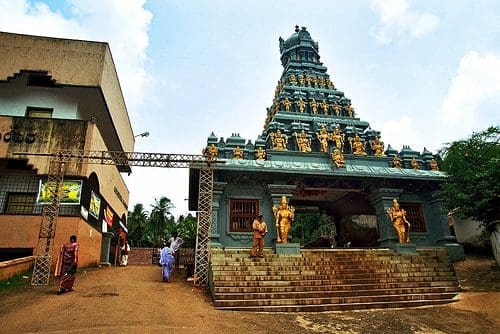
Location
The Manjunath Temple, at the foot of Kadri Hills, attracts devotees and tourists in thousands. The temple dates back to about 1068 AD and is built in the Vijaynagar style of architecture. It is neat and middle-sized with a homogenous main building that imparts a squarish look to the temple. Dakshina Kannada is the home of many such Manjunath temples, the most famous among them being the Dharmasthala and Kadri temples.

A tall wooden deepa sthamba with a bronze covering greets you as you climb up to the temple. The huge bronze statue of Trilokeshwara that catches one’s attention in the temple dates way back to 968 AD. This life sized, three faced, six armed figure of the seated Bodhisathva with enameled eyes and an intricately carved mukuta is surrounded by a well curved prabhavali and two attendants–giving the idol an aura of divinity
Surprisingly, the temple has traces of Buddhist influence. This is evident from the presence of ../circuitimages of the Buddha with reliefs of Garuda. Historians explain and accept this as Vaishnavite divinity representing a phase of transformation of the Buddha as the avtaar of Vishnu. The garuda relief at the pedestal apparently escaped the eyes of archaeologists. The hill has caves and muths, said to belong to the Natha Panthas, which is believed to be an offshoot of the Vajrayana form of Buddhism.
The presiding deity is Shree Manjunatha, Udbhava Linga, which is a natural stone slab found almost parallel to the level of the floor of the garbha griha. An amazing fact is that any amount of water poured on it disappears immediately. There are two figures, one of which is that Matsyendranatha in the southern niche seated in the padmasana pose and having his palms held one over the other on his folded right leg. The other figure is that of Sringinatha, which has a three-hooded serpent over its well-carved krita, which is ornamented with three tiers behind it. The central niche, on the western side, has a male figure said to be that of Gokaranatha which is nearly six feet tall. The sub-deities in the temple are Durgaparmeshwari, Ganapathi, Shastavee and Gomukha Ganpathi, Trilokeshwara, Vyasa Muni and Vishnu. Each of these sub-deities has a smaller shrine dedicated to them.
In the north at an elevation are the temple’s nine tanks with a perennial water supply. The water in this tank has never dried up to date and has been a major source for the temple and the people living nearby.

The Kashi Bhagirathi Teertha water flows out through a small opening, throughout the year in the Gomukha Ganpathy temple. But nobody has been able to identify the source from where the water originates.
Outside the temple is a piece of wood called the kodi mara that measures up to 65 feet. People of the Mogaveera community manually erect this piece of wood every year on Makara Sankranthi (January 14). The kodi mara is brought down only in May.
Festival
Makara Sankranthi, which is also the annual festival of the temple, is celebrated on a grand scale. Pujas and balis are performed continuously for nine days. The eighth day marks the Rathotsava. The last day of the festival is the Laksha Deepotsatva, which falls on Karthikamavasya. On this day the temple is lit up with lights and lamps.

1 Trackback / Pingback